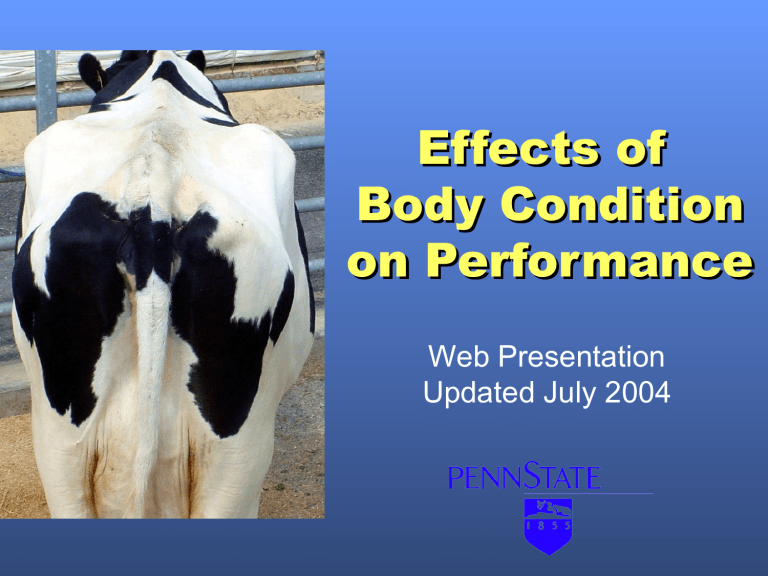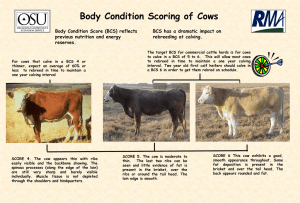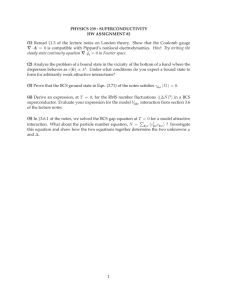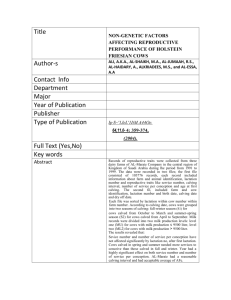
Effects of Body Condition on Performance Web Presentation Updated July 2004 Using body condition scoring to fine tune herd nutrition and health management has become a widely accepted practice. This presentation will examine the influence of body condition on milk production, dry matter intake, reproduction, and health of cows in your herd Nutrient and Milk Yield Relationships in the Lactation and Gestation Cycle Periods 1 2 Body Stores Used for Milk Production 3 4 Body Stores Regained for Next Lactation Dry Matter Intake 5 Dry Period Rumen Rehab Mil kP rod uct ion Body Weight Freshening 0 1 2 3 4 5 6 Month 7 8 9 10 11 12 BCS and Milk Production BCS at calving < 2.75 reduced milk yield > 3.25 reduced milk yield Penn State & Cornell research shows cows with a BCS >3.25 at calving produce 5 pounds less milk each day than cows with lower BCS during the first 30 days of lactation BCS change after calving Decrease of 1 BCS unit increase of 930 lb milk in 305-d lactation Body reserves essential to support milk production Waltner et al., 1993 Pedron et al., 1993 BCS and Increased Health Risk Excess Body Condition Fat Cow Syndrome Ketosis Displaced Abomasum Milk Fever Metritis Mastitis Lameness Limited Dry Matter Intake Thin Body Condition Lameness Metabolic problems can set the stage for consequences of other nutritional-stress complications, including infections such as mastitis. BCS and Reproduction Cows > 3.75 BCS at dry off were 2.8 times more likely than cows with average BCS to experience the following reproductive problems in their next lactation Dystocia Retained placenta Uterine infection Cystic ovaries Abortion Gearhart et al., 1990 Relationship between BCS Loss in First 5 Weeks after Calving and Reproduction Body Condition Loss Item # Cows < 0.5 17 0.5 to 1.0 64 > 1.0 12 Days to first ovulation Days to first heat 27a 48ab 31a 41a 42 b 62b Days to first service First service conception rate, % Services per conception Pregnancy rate, % 68a 67a 79 b 65a 53a 17 b 1.8 94 2.3 95 2.3 100 Means in a row with different superscripts differ P < 0.05 Butler and Smith, 1989 In Summary. . . BCS changes can cause problems when they are Too Little Too Much Too Rapidly Changed Managing Body Condition Loss Avoid over conditioning If cows are fat at dry off Do Not allow BCS loss during dry period Body condition score dry cows to monitor changes Maximize dry matter intake of close up and fresh cows to limit negative energy balance BCS Loss in High Producers High-producing cows can lose between 100 to 150 pounds during the first 60 to 80 days (the equivalent of 1 BCS unit) Rate of 1 to 2 pounds per day But weight loss of 3 to 4 pounds per day May increase the possibility of metabolic disorders such as ketosis May discourage implantation of the fetus, resulting in cows that are "apparently not conceiving" More on High Producers Negative energy balance is common for high-producing cows in early lactation Mobilized body fat is used to produce milk 1 pound of mobilized fat = 7 pounds of milk Our goal is to minimize weight loss by encouraging intake of High quality, highly palatable forage dry matter at 1.8 to 2.0% of body weight daily Sufficient grain, the quantity being gradually increased over the first few weeks of lactation Managing Body Condition Gain Add body condition in late lactation Efficient storage of energy Monitor BCS of lactating cows to identify thin and fat cows early, in time to make adjustments before drying off Avoid changes in BCS during dry period Very thin cows may benefit from extra feed in the early dry period More on Body Condition Gain Cows should start replenishing fat reserves after reaching peak milk A few cows, 5 to 10%, may never put on much flesh A similar proportion may be "easy keepers" and tend to be obese most of the time BCS Changes Over Lactation Efficient, high producing cows do not experience large changes in body condition Inefficient, low producing cows increase in BCS over a lactation Most cows are between these extremes BCS decreases to about 100 days Then increases until dry-off Recommended BCS by Stage of Lactation BCS Stage of Lactation Calving Early Lactation Peak Milk Mid Lactation Late Lactation Dry Off DIM Goal Min Max 1 to 30 31 to 100 101 to 200 201 to 300 > 300 3.50 3.00 2.75 3.00 3.25 3.50 3.25 2.75 2.50 2.75 3.00 3.25 3.75 3.25 3.00 3.25 3.75 3.75 BCS at Calving Recommended Score: 3.25 to 3.75 Nutritional Objective: Cows calve with adequate, but not excessive, body-fat reserves Red Flags – Calving BCS < 3.25 Too little energy provided in late lactation or dry period Risk low milk production Especially if ration is not balanced or not palatable BCS > 3.75 Too much energy provided in late lactation or dry period Separate dry cows from milking herd Feed low-energy ration balanced for protein, minerals, and vitamins Niacin may help Reduce ketosis Increase fat mobilization Increase appetite BCS in Early Lactation Recommended Score: 2.75 to 3.25 Nutritional Objectives: Maximize intake of a highenergy ration Minimize body condition loss and offset negative energy balance Ration must contain enough protein to support high milk production Red Flags – Early Lactation BCS < 2.75 and low milk production Too little energy provided in ration High producers may drop below 2.75, but condition must be regained to prevent reproductive problems BCS > 3.25 Too little protein provided in ration to support milk production Check intake of water, minerals, and vitamins BCS at Peak Milk Yield Recommended Score: 2.5 to 3.25 Nutritional Objectives: Maximize intake of a highenergy ration Minimize body condition loss and offset negative energy balance Ration must contain enough protein to support high milk production Red Flags – Peak Milk BCS < 2.5 and low milk production Too little energy provided in ration BCS > 3.25 Too little protein provided in ration Check intake of water, minerals, and vitamins BCS in Mid Lactation Recommended Score: 2.75 to 3.25 Nutritional Objectives: Maintain body condition Begin to gain condition for maximum milk production Avoid excessive body weight gain Red Flags – Mid Lactation BCS < 2.75 Too little energy provided in ration Problem probably began in early lactation BCS > 3.25 Reduce energy intake to avoid over conditioning BCS in Late Lactation Recommended Score: 3.0 to 3.75 Nutritional Objectives: Replenish body reserves to prepare for next lactation Avoid over conditioning Red Flags – Late Lactation BCS < 3.0 Too little energy provided in ration Problems likely began earlier in the lactation BCS > 3.75 Too much energy provided in ration Also may result from extended calving intervals BCS at Dry Off Recommended Score: 3.25 to 3.75 Nutritional Objectives: Prepare for next lactation Maintain condition through dry period – do not lose, especially if cows enter dry period fat Avoid over conditioning by feeding low-energy ration with adequate protein, minerals, and vitamins Red Flags – Dry Cows BCS < 3.25 Too little energy provided in ration Problems likely began earlier in the lactation BCS > 3.75 Too much energy provided in ration Also may result from extended calving intervals Avoid BCS loss in dry period Summary of Body Condition Score Changes over a Lactation BCS at calving affects lactation performance If too thin, peak milk yields will be low and reproduction will be delayed If too fat, metabolic diseases are very likely Early lactation – BCS lost Used to support milk production Extreme loss hurts reproductive activity By 80 to 120 days into the lactation Weight loss should be minimal Cows should begin to regain condition Essential for strong exhibition of estrus (heat) and conception After 120 days, all cows should be gaining about 0.75 to 1.0 pounds per day If a cow enters the dry period fat If a cow enters the dry period thin Maintain body condition – DO NOT LOSE May add a little condition early (first 3 weeks) Section 3 will look at ways to identify and address body condition problems Charting body condition during a lactation can help troubleshoot herd problems See extension.psu.edu/dairynutrition to download spreadsheet that plots BCS and compares your animals to ecommendations Troubleshooting Tips Indicators of body condition problems Increase of 5 to 10% in rate of metabolic disease Cows not able to maintain persistency or peak at expected levels of milk production Wouldn’t you rather find these problems before cows get sick and milk drops??? Score cows regularly to predict – and address – potential problems before they happen Suggested BCS Schedule Calving 30 days after calving First breeding Pregnancy check 60 days before dry-off Dry-off Possibly mid dry period if cows are having problems at calving or during early lactation Compared to Recommended Body Condition Score PSU 109 4.50 4.00 Body Condition Score 3.50 3.00 2.50 2.00 Normal Change Lactation 4 118 lb Peak Milk, at 42 DIM 305-d milk 27,510 lb 1.50 Your Cow Goal Min Max 1.00 -60 -30 0 30 60 90 120 150 180 210 Stage of Lactation - Days in Milk 240 270 300 330 360 Compared to Recommended Body Condition Score PSU 263 4.50 4.00 Body Condition Score 3.50 3.00 2.50 2.00 Small Heifer with High Production First Lactation, calved at 23 months 104 lb Peak Milk, at 140 DIM 305-d milk 24,730 lb 1.50 Your Cow Goal Min Max 1.00 -60 -30 0 30 60 90 120 150 180 210 Stage of Lactation - Days in Milk 240 270 300 330 360 Compared to Recommended Body Condition Score PSU 836 4.50 4.00 Body Condition Score 3.50 3.00 2.50 2.00 High Production Lactation 4 178 lb Peak Milk, at 35 DIM 305-d milk 36,590 lb 1.50 Your Cow Goal Min Max 1.00 -60 -30 0 30 60 90 120 150 180 210 Stage of Lactation - Days in Milk 240 270 300 330 360 Compared to Recommended Body Condition Score PSU 975 4.50 4.00 Body Condition Score 3.50 3.00 2.50 2.00 Low Production Lactation 4 97 lb Peak Milk, at 28 DIM 243-d Lactation 16,530 lb milk 1.50 Your Cow Goal Min Max 1.00 -60 -30 0 30 60 90 120 150 180 210 Stage of Lactation - Days in Milk 240 270 300 330 360 Plan to Address BCS Problems Nutrition Checklist Dry Matter Intake – especially of forages Feeding sequence Fiber level of rations Feeding frequency Ration palatability Bottom line Make sure cows are eating enough Provide at least 45% of DMI from forage sources If those are adequate… Check ration to be sure it is properly balanced for Test the forages and balance rations for each group of cows Protein, energy, minerals, and vitamins When feeding hay crop silages, be sure to analyze for bound protein and adjust the ration accordingly Examine grain and forage quality – focus on Fineness of chop or grind of the ingredients Smell, acceptability, and pH Look at the amounts of bypass protein, soluble protein, starch ingredients, fats, and oils in the ration How to Achieve High Milk Yields Feed good-to-excellent quality forages that stimulate eating and enable cows to produce up to their maximum genetic potential Nutritional Strategies to Manage BCS: Early Lactation Feed extra energy in early lactation to offset negative energy balance Added fat from oil seeds – no more than 5% of total ration dry matter Higher levels upset rumen fermentation and decrease forage digestibility Additional fat from bypass or protected fats (rumen inert) – an additional 2% of ration dry matter Total fat in ration should not exceed 7% When oils and fats are added to the ration Increase calcium, magnesium, phosphorus 10% on a dry matter basis Nutritional Strategies to Manage BCS: After Peak Milk Cows should be gaining 0.75 to 1 lb per day Balance ration to avoid over conditioning If cows are getting too heavy Protein may be limited, energy may be excessive Nutritional Strategies to Manage BCS: Dry Cows If cows fat at dry-off Maintain condition to avoid weight loss Feed average quality grass forages Supplement 3 to 4 pounds of grain Or, minimal amounts of corn silage and a grass hay mixture If cows are thin at dry-off Feed good quality grass forages Supplement 3 to 4 pounds of grain



